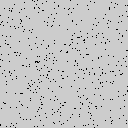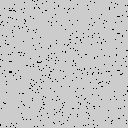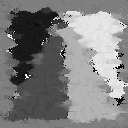Difficult data
Artificial stimuli, as well as images taken in a technical context, are
sometimes composed of large homogeneous image areas. In this case, several kinds
of random intensity variations can be much more prominent than the intensity
variations induced by the object surfaces. For those image areas, no valid
disparity estimate can be obtained by any method.
The coherence-based stereo
algorithm is able to detect areas with a bad disparity estimate because
a verification count is available within the network structure.

left picture
|

right picture
|
|

calculated disparity
|

verification count
|

verified data
(threshold=0.2)
|
Using the verification count for thresholding, coherence-based stereo can
mimic a classical feature-based algorithm when confronted with difficult
data. However, feature-based stereo algorithms have to preselect the
image features they are using. And only in image regions where these
preselected features are found a disparity estimate can be obtained. If
image detail is present, but not of the chosen feature type, no estimates
can be calculated by classical feature-based approaches.
In contrast, the new coherence-based stereo algorithm is a
feature-less algorithm; disparity is obtained in all image regions
with sufficient detail, independent of the type of detail present.
Filling-In
In sparse random-dot stereograms, filling-in is known to occur in human
stereovision. Filling-in interpolates missing disparity values based on
disparity estimates of neighboring image regions.
Filling-in is usually realized with cooperative algorithms refining
iteratively an initial estimate of the disparity map. This process can last
several hundred iterations, and slows down these types of algorithms.
Within the coherence-based stereo, filling-in occurs from
coarser spatial channels whenever the verification count of the fine
resolution channels is not sufficient for a valid disparity estimate. This
is a non-iterative process which fits naturally into the
coherence-detection scheme. Specifically, there is no need for further
iterative refinement. In addition, the verification
count mentioned above can be used to mark those regions which have been
filled-in by coarser channels.
As an example for filling-in, the following figure displays a random-dot
stereogram with a pixel density of only 3%, together with its
calculated and its true disparity map.

left picture
|

right picture
|

calculated disparity
|

true disparity
|
Comments are welcome!
© 1997 by Rolf Henkel - all rights reserved.
|

